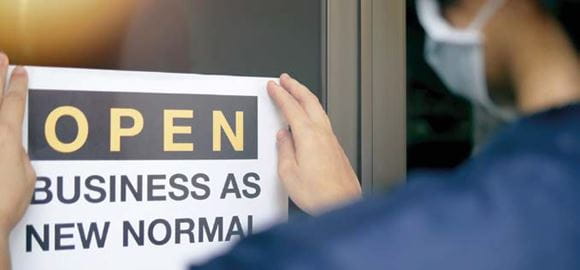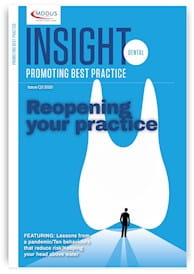 AS practices start to reopen their doors to patients, dental principals face the task of getting their teams ready to get back to practice.
AS practices start to reopen their doors to patients, dental principals face the task of getting their teams ready to get back to practice.
Any staff who have been furloughed will need to be given notice that their leave is coming to an end, however, there is no minimum notice period set out in law.
Due to the ongoing restrictions, it may not be practical for all staff to return at once, in which case a selection process can be arranged. Decisions around who returns to work and who remains on furlough should be made in line with the needs of the business. This can also work on a rotational basis. Make decisions fairly and consistently to avoid accusations of treating employees differently in relation to protected characteristics such as age, race, disability etc.
Make time to speak to each person before they return to discuss any issues or concerns they may have. This is a good opportunity to also reassure the team by highlighting the extra safety measures in place, for example additional personal protective equipment (PPE), amended room layouts or limits on patient numbers/treatment types, and sharing with them your documented risk assessment/operating procedure. Deal with any concerns sensitively and try to find solutions where possible. Remember that staff do have the right to raise health and safety concerns and have legal protection from any punishment or detriment for doing so.
Some employees may indicate that they wish to remain on furlough until the end of the scheme in October. This type of leave is not a right and it is for the practice to decide whether this is appropriate for each employee. But if work is available, then staff should return to practice.
Safe to return?
Some staff will still be unable to return to work if they develop symptoms (10 days) or if anyone in their household has symptoms (14 days). These employees should receive statutory sick pay (SSP) from day one as a minimum but paying contractual sick pay should be considered. From July 31, those who received shielding letters in Scotland, England and Northern Ireland no longer have to take special measures to avoid the disease. The latest British Dental Association (BDA) guidance is that these employees should continue to receive full pay, even if they are unable to work from home, although it is ultimately a matter for individual employees.
Pregnant employees do not automatically need to stay away from the workplace, but if there are health and safety concerns then other options, such as working from home, should be considered. However, practices should be mindful that there may be some aspects of work at a dental practice where, even with additional PPE, the risk of catching COVID-19 is higher than it would be outside the workplace. If adequate changes can’t be made to protect the employee, then they should remain at home on full pay.
The BDA have advised that, after 28 weeks, pregnant workers should not see patients in a face-to-face setting. Where that is not possible, the employer is obliged to place them on full pay until the start of the employee’s maternity leave.
Staff who are vulnerable
Staff who are classed as vulnerable may continue to work in a dental practice if working from home is not possible and all necessary risk assessments have been undertaken with all relevant PPE provided.
If employees refuse to agree to such an arrangement, alternative arrangements need to be considered such as continuing furlough leave, taking holiday or unpaid leave.
The BDA have advised that those employees who fall into the extremely vulnerable category, should not see patients in a face-to-face setting.
Childcare
As dental practice staff are deemed key workers, they should already have access to childcare places. This should be further alleviated as schools and early years’ childcare start to reopen. For those employees who say childcare is still a problem, speak to them to find out their concerns and to ascertain what measures can be put in place to allow them to return. This could include working from home or working flexible hours. If the employee still refuses to return to work, then they could consider taking annual leave or parental leave. Otherwise the leave will be unpaid.
Anxiety
You may have some employees who do not fall into any of the above categories but are resistant and anxious about returning to work. Remain open minded and reasonable. Set up a meeting (virtually if necessary) with the employee to discuss their concerns and offer reassurances as to the safety measures the practice has put in place. Consider any further suggestions the employee may have. Other options may be again working from home, reduced hours or amended duties. If the employee still refuses to come in, with no valid reason, this may lead to disciplinary action for unauthorised absence or possibly a capability dismissal but advice should be sought before taking any action. Employees with genuine health and safety concerns will have employment protection and they must not be subject to any action or detrimental treatment.
Holidays
During this time, normal employment rights apply and staff continue to accrue holidays. Many employees may be reluctant to use annual leave, but practices don’t want a bottleneck of requests later in the year. Encourage staff to take holidays that are already booked. Or consider asking them to take, for example, a week’s holiday by the end of September. Those who refuse can be required to take holidays by the employer giving the employee double the normal notice period, so 10 days’ notice for five days’ holiday. But bear in mind that the purpose of a holiday is for the employee to enjoy rest and relaxation, which may not be so easy in the current situation. It would be unreasonable to ask staff to take the bulk of their holiday entitlement during a period of furlough leave. The Government has also advised that staff will be able to carry over four weeks’ annual leave over a two-year period if it is not practical for them to take the leave during the holiday year.
Further guidance
The BDA have issued guidance to assist practices in aiding staff to return to work and some recommendations include:
- All staff should be risk-assessed on an ongoing basis, including taking daily temperature checks. As this is sensitive data, it is important to remember to respect employees’ confidentiality.
- Anyone with symptoms should not be permitted to work and should return home to self-isolate. They can request a test and, if negative, return to work.
- In line with Government advice, it is recommended that as part of risk assessment, dental services review the resource requirements for service operations and commitments. Where appropriate, this should allow staff to stay at or work from home to avoid non-essential travel and contact; or to participate in local workforce redeployment efforts in line with local arrangements.
- Staff uniforms should be removed at the practice at the end of shift and laundered.
This page was correct at the time of publication. Any guidance is intended as general guidance for members only. If you are a member and need specific advice relating to your own circumstances, please contact one of our advisers.
Read more from this issue of Insight Dental

Save this article
Save this article to a list of favourite articles which members can access in their account.
Save to library